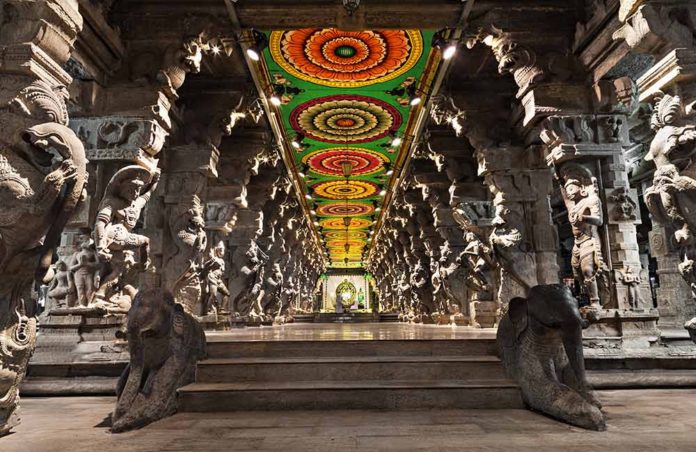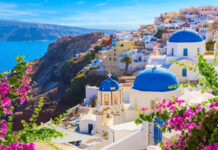Meenakshi Amman Temple, otherwise called Minakshi-Sundareshwara Temple, is one of the most seasoned and most significant temples in India. Situated in the city of Madurai, the temple has an extraordinary legendary and authentic importance. It is accepted that Master Shiva expected the type of Sundareswarar (the attractive one) and wedded Parvati (Meenakshi) at the site where the temple is at present found. Eminent for its bewildering design, Meenakshi Temple was designated as one of the miracles of the world, yet couldn’t make it into the rundown of ‘Seven Marvels of the World’. In any case, the temple is certainly one of the ‘Marvels of India’. It is likewise one of the primary attractions of South India with a large number of lovers swarming it consistently. During the ‘Tirukalyanam Celebration,’ which happens over a time of 10 days, the temple pulls in excess of 1,000,000 fans. In spite of numerous individuals visiting it consistently, the temple is very much kept up and was named the ‘Best Swachh Notable Spot’ (cleanest notable spot) in India.
Folklore
As per a legend, Meenakshi arose out of a ‘Yajna’ (sacrosanct fire) as a three-year-old young lady. The ‘Yajna’ was performed by a ruler named Malayadwaja Pandya alongside his better half Kanchanamalai. Since the illustrious couple had no kid, the Ruler offered his petitions to Master Shiva, mentioning him to give them a child. Be that as it may, sadly, a triple-breasted young lady arose out of the sacrosanct fire. At the point when Malayadwaja and his significant other communicated their anxiety over the young lady’s strange appearance, a heavenly voice requested them not to worry over the young lady’s actual appearance. They were additionally educated that the young lady’s third bosom will vanish when she meets her future spouse. The mitigated Ruler named her Meenakshi and at the appropriate time delegated her as his replacement.
Meenakshi governed over the old city of Madurai and furthermore proceeded to catch the adjoining realms. Rumours have spread far and wide suggesting that she even caught Indralok, the residence of Master Indra, and was headed to catch Kailash, the dwelling place of Ruler Shiva, too. At the point when Shiva showed up before her, Meenakshi’s third bosom vanished and she realized that she had met her significant other. Shiva and Meenakshi got back to Madurai where their wedding occurred. It is said that the wedding was gone to by every one of the divine beings and goddesses. Since Parvati herself had accepted the type of Meenakshi, Ruler Vishnu, Parvati’s sibling, given her over to Master Shiva. Indeed, even today, the wedding function is commended each year as ‘Chithirai Thiruvizha’ which is otherwise called ‘Tirukalyanam’ (the great wedding).
History
- The historical backdrop of Meenakshi Temple traces all the way back to the first century C.E with researchers asserting it to be pretty much as old as the actual city. It is said that Kulashekarar Pandyan, a ruler who controlled over the Pandyan line, assembled the temple according to the guidelines given in his fantasy by Master Shiva. A couple of strict writings that have a place with the first to fourth century C.E talk about the temple and depict it as the focal design of the city. Writings tracing all the way back to the mid sixth century, portray the temple as where researchers met to talk about significant themes. The temple the way things are today, be that as it may, was reconstructed all through the sixteenth century as it was annihilated by the Muslim intruders.
- During the fourteenth century C.E, Malik Kafur, a commandant of Delhi Sultanate, driven his military into most pieces of southern India and plundered numerous temples including the celebrated Meenakshi Temple. Assets, for example, gold, silver and valuable pearls were taken to Delhi. Since temples in those days had plenitude of resources, the vast majority of the temples were obliterated and were left in ruins. At the point when the Vijayanagar Realm took over Madurai subsequent to overcoming the Muslim Sultanate, the temple was remade and returned. The temple was additionally extended during the late sixteenth century and mid seventeenth century by Vishwanatha Nayakar, a ruler of the Nayaka administration. As per scientists, while reconstructing the temple, the leaders of Nayaka tradition followed the structural style of ‘Silpa Shastras.’ ‘Silpa Shastras’ are a bunch of building laws found in the old writings.
- The temple was indeed extended by Thirumalai Nayak who controlled over Madurai from 1623 to 1655. During his rule, many ‘Mandapams’ (pillared corridors) were assembled. The temple was then extended by numerous later Nayaka rulers before the approach of the English East India Organization. The temple was indeed corrupted and parts of it were obliterated during the English Principle. In 1959, the rebuilding work was begun by Tamil Hindus by gathering gifts and by teaming up with students of history and architects. The temple was totally reestablished in 1995.
Temple Construction
The temple involves an immense zone in the core of Madurai as it spreads more than 14 sections of land. The temple is encased with enormous dividers, which were implicit reaction to the attacks. The whole construction, when seen from a higher place, addresses a mandala. A mandala is a design worked by the laws of balance and loci. There are different sanctuaries worked inside the temple complex. Aside from the two principle altars, which are committed to Sundareswarar and Meenakshi, the temple has holy places devoted to different divinities like Ganesha and Murugan. The temple additionally houses goddesses Lakshmi, Rukmini, and Saraswati.
The temple additionally has a blessed lake named ‘Porthamarai Kulam.’ The term ‘Potramarai Kulam’ is an exacting interpretation of ‘lake with a brilliant lotus.’ The development of a splendid lotus is put at the point of convergence of the lake. It is said that Ruler Shiva favored this lake and pronounced that no marine life would fill in it. In the Tamil legends, the lake is accepted to be an evaluator for auditing the value of any new writing.
The temple has four primary transcending entryways (gopurams) that appear to be indistinguishable from one another. Aside from the four ‘gopurams,’ the temple likewise houses numerous other ‘gopurams’ that fill in as passages to various hallowed places. The temple has an aggregate of 14 transcending doors. Every single one of them is a multi-story construction and showcases a large number of fanciful stories and a few different figures. The major ‘gopurams’ of the temple are written below:
- Kadaka Gopuram – This transcending passage prompts the principle sanctuary that houses Goddess Meenakshi. The entryway was modified by Tumpichi Nayakkar during the mid-sixteenth century. The ‘gopuram’ has five stories.
- Sundareswarar Place of worship Gopuram – This is the most seasoned ‘gopuram’ of the temple and was worked by Kulasekara Pandya. The ‘gopuram’ fills in as an entryway to the Sundareswarar (Ruler Shiva) holy place.
- Chitra Gopuram – Worked by Maravarman Sundara Pandyan II, the gopuram portrays the strict and mainstream substance of Hinduism.
- Nadukkattu Gopuram – Additionally called as the ‘Idaikattu Gopuram,’ this passage prompts the Ganesha holy place. The door is set right in the middle of the two fundamental holy places.
- Mottai Gopuram – This ‘gopuram’ has less plaster pictures when contrasted with different doors. Curiously, ‘Mottai gopuram’ had no rooftop for almost three centuries.
- Nayaka Gopuram – This ‘gopuram’ was worked by Visvappa Nayakkar around 1530. The ‘gopuram’ is incredibly like another entryway called ‘Palahai Gopuram.’
The temple likewise has various pillared corridors called ‘Mandapams.’ These lobbies were worked by different rulers and rulers and they fill in as resting places for pioneers and fans. Probably the most significant ‘mandapams’ are given underneath:
- Ayirakkal Mandapam – It in a real sense means ‘corridor with thousand columns.’ The lobby, which was worked by Ariyanatha Mudaliar, is a genuine display as it is upheld by 985 columns. Every single column is etched wonderfully and has pictures of Yali, a legendary animal.
- Kilikoondu Mandapam – This ‘mandapam’ was initially worked to house many parrots. The parrots that were kept there in confines were prepared to say ‘Meenakshi’. The corridor, which is close to the Meenakshi holy place, has models of characters from Mahabharata.
- Ashta Shakthi Mandapam – This corridor houses the models of eight goddesses. Worked by two sovereigns, the lobby is put in the middle of the fundamental ‘gopuram’ and the passage that prompts the Meenakshi place of worship.
- Nayaka Mandapam – ‘Nayaka Mandapam’ was worked by Chinnappa Nayakkar. The lobby is upheld by 100 columns and houses a Nataraja sculpture.
The temple complex is the focal point of the old city of Madurai. It comprises of landmarks inside various concentric fenced in areas, each layer invigorated with high workmanship dividers. The external dividers have four transcending entryways, permitting enthusiasts and pioneers to enter the complex from every one of the four bearings. After the city’s obliteration in the fourteenth century, the Tamil custom expresses that the lord Vishwantha Nayaka remade the temple and the Madurai city around it as per the standards set down in the Shilpa Shastras (Sanskrit: śilpa śāstra. The city plan depends on concentric squares with roads transmitting out from the temple. [11] Early Tamil writings notice that the temple was the focal point of the city and the roads turned out to be emanating out like a lotus and its petals. The temple prakarams (external regions of a temple) and roads oblige a detailed celebration schedule in which parades circumambulator the temple complex. The vehicles utilized in the parades are dynamically more gigantic the further they travel from the centre.
The temple complex is spread over around 14 sections of land (5.7 ha). The patio is near a square with each side of around 800 feet, however more precisely a square shape with one side around 50 feet longer. The complex has various altars and mandapas, of which the most significant and biggest are the two equal sanctuaries in the deepest yard, one for Meenakshi (B on the arrangement) and other for Sundareshvara (A). Moreover, the complex has a brilliant lotus sacrosanct pool (L) for pioneers to wash in, 1,000 column lobby choultry with broad figure (Q), the kalyana mandapa or wedding corridor, numerous little holy places for Hindu divinities and for researchers from the sangam (institute) history, structures which are strict schools and authoritative workplaces, elephant sheds, hardware sheds, for example, those for holding the chariots utilized for intermittent parades and some gardens.The temple is installed inside a business center point and conventional markets.
As indicated by Holly Reynolds, a nearer assessment of the temple plan, just as the old city, proposes that it is mandala, an inestimable graph spread out dependent on standards of evenness and loci.
The temple complex has had a living history, has been being used for practically the entirety of its set of experiences aside from around 60 years when it was shut and in ruins after its annihilation in the fourteenth century. The temple has kept on developing in the cutting edge period. For instance, before the provincial time, the temple complex was itself inside another layer of old city’s braced dividers. The English obliterated this layer of fortress in the mid nineteenth century. The enduring arrangement of the temple complex spots it inside the old city, one characterized by a bunch of concentric squares around the temple.
Dividers
- The old temple complex was open. The patio dividers were added over the long haul in light of attack and the loot of the temple complex. As indicated by the content Thirupanimalai, the Vijayanagara authority Kumara Kampana subsequent to finishing his triumph of Madurai, modified the prior structure and fabricated guarded dividers around the temple in the fourteenth century. Lakana Nayakar added the cautious dividers around the first prakara (yard), just as extended and redesigned the Mahamandapa and Meenakshi altar about the center of the fifteenth century.
- After the obliteration of the Hindu Vijayanagara Domain in the late sixteenth century by an alliance of Islamic Deccan sultanates north of Karnataka, the Madurai district announced its power. Visvanatha Nayak at that point poured assets to vigorously invigorate the temple unpredictable, set another arrangement for the temple complex. The Nayaka ruler likewise plated the vimana of the essential holy places with gold. Chettiappa Nayakkar reconstructed the Dvarapala mandapam before the Sannadhi gopuram, just as the north corridor of the Brilliant Lotus Tank, the second defensive divider around the Meenakshi Devi’s place of worship.
Sanctums
- The Meenakshi temple has two separate special stepped areas for the goddess Meenakshi (Parvati, Devi, Amman) and god Sundaresvara (Shiva, Deva, Cuvami), really like most Shaiva temples.Both open toward the east. The Devi sanctum is on the south side (B), while the Deva sanctuary is all the more midway positioned, toward the north (A), in this way setting the goddess as the pradhana murti or the “more significant” right side inside the intricate, states Fuller.
- The goddess sanctum has the green stone picture of Meenakshi, remaining in bowed leg act. Her lifted hand holds a lotus, on which sits a green parrot. Her left hand hangs close by. This picture is set in a square garbha griya (focal sanctum). A duplicate of this picture has been produced using metal and is kept in the temple complex. The metal rendition is utilized for a merry parade. A particular component of Meenakshi as far as iconography is the presence of parrot in her correct hand. The parrot is by and large connected with the Vaishnava azhwar holy person Andal. The Sundareswarar holy place has a stone linga in its square arrangement sanctum, and this anicon is concealed under a stone cobra hood. In the upper east corner is another stone picture of his associate. None of these movement during a merry parade. Or maybe, Sundareswarar is addressed as human Somaskanda picture. There is another metal representative picture of Shiva called the Cokkar, which is only a couple of emblazoned feet on a metal stool. This image is kept close to Sundareswarar sanctum throughout the day, at that point conveyed in a palaki day by day to Meenakshi’s chamber each evening so the two can emblematically go through the night together. Toward the beginning of the day, the temple volunteers wake the heavenly couple and the representative Cokkar picture is conveyed back to the Sundareswarar sanctum.
- The holy place for Sundareswarar is the biggest inside the complex and its passageway is lined up with the eastern gopuram. The place of worship for Meenakshi is more modest, however philosophically more significant. Both the Meenakshi and Sundareswarar hallowed places have gold plated Vimanam (overshadow sanctum). The brilliant top can be seen from a huge span in the west through the openings of two progressive pinnacles. The tall model of Ganesh cut of single stone situated external the Sundareswarar hallowed place in the way from Meenashi sanctuary is known as the Mukuruny Vinayakar. An enormous proportion of rice estimating 3 kurini (an action) is formed into a major chunk of penance and henceforth the Ganesh is called Mukkurni Vinayagar (three kurinis).
- Kumara Kampana, states the Thirupanimalai text, given diamonds and made honours to take care of the expenses for step by step exercises of the two blessed spots in the fourteenth century. The Tamil Hindus who had covered up the temple symbols in Nanjil Nadu, brought them back and reconsecrated them finishing the almost fifty years’ time when the temple had been shut under the Madurai Sultanate rule. The temple engravings propose that the Vijayanagara rulers partook love functions in the temple and gave gold, through the sixteenth century. Lakana Nayakar constructed the Paliarai (bed chamber) during the fifteenth century for the symbol goddess and god to emblematically go through their night together. The Nataraja place of worship was additionally included the fifteenth century by Arulalan Sevahadevan Vanathirayan, who likewise remodeled the Thiruvalavaudaiyar altar.
- The temple has different sanctuaries, for example, for Murugan in the northwest corner of the subsequent patio. It was worked by Krishnappa Nayakar II.A tall, solid Ganesha design with a huge rice ball, privately called the Mukuruny Vinayakar, is cut in transit between the Meenakshi place of worship and the Sundareshwarar sanctum, mirroring the legend that gave him the elephant head
Importance and Love
Since Meenakshi is the primary god of the temple, the temple connotes the significance of lady in a Tamil Hindu family. The temple likewise depicts the warm connection between Shaivism, Vaishnavism and Shaktism. The Sundareswarar hallowed place is known as one fifth of ‘Pancha Sabhai’ (five courts) where Master Shiva is accepted to have played out the infinite dance. Love fundamentally includes customs and parades. One of the ceremonies includes putting a picture of Sundareswarar inside a cart which is then moved to the altar of Meenakshi. The cart is taken into the altar consistently and is taken back to the holy place of Sundareswarar each day. The aficionados as a rule love Meenakshi prior to offering their supplications to Sundareswarar.
Celebrations
- Aside from the principle celebration, which is essentially the wedding service of the divinities, various different celebrations are commended in the temple. A portion of these incorporate ‘Vasantham celebration,’ ‘Unjal celebration,’ ‘Mulai-Kottu celebration,’ ‘Arudhra Dharsan celebration,’ ‘Thai utsavam,’ ‘Kolattam celebration,’ and so on Every one of these celebrations has its own importance and is praised during different months consistently. The temple additionally observes ‘Navarathri celebration.’ During ‘Navarathri’ the temple shows bright dolls which are all in all called ‘gollu.’ ‘Gollu’ frequently pass on stories from fanciful scenes.
Location
The Meenakshi temple is situated in the core of memorable Madurai city, about a kilometer south of the Vaigai Stream. It is around 460 kilometers (290 mi) southwest from Chennai, the state capital. The temple complex is all around associated with street organization (four path Public Roadway 38), almost a significant rail route intersection and an air terminal (IATA: IXM) with every day administrations. The city streets emanate from the temple mind boggling and significant ring streets structure a concentric example for the city, a construction that follows the Silpa Sastra rules for a city plan. Madurai is one of the numerous temple towns in the state which is named after the forests, groups or backwoods overwhelmed by a specific assortment of a tree or bush and a similar assortment of tree or bush protecting the managing god. The locale is accepted to have been covered with Kadamba woods and consequently called Kadambavanam.
Literacy mention
- Throughout the long term, the temple has been a focal point of training of culture, writing, craftsmanship, music and dance.
- The temple is popular area where Tamil custom trusts Sambandar set up Tamil Shiva bhakti.
- Kumaraguruparar, a seventeenth century Tamil writer, formed Meenakshi Pillaitamil in recognition of directing divinity of this temple. [Ruler Tirumalai Nayak’s support of the artist Kumaraguruparar has a significant spot in the historical backdrop of pillaitamil (a class of Tamil writing). Kumaraguruparar visited a great deal of temples and when he visited this temple, he formed Meenakshi pillaitamil devoted to the goddess Meenakshi.
Shyama Shastri, one of the Trinity of Carnatic music, had made a set out of nine Telugu melodies in commendation of Meenakshi of Madurai, which are alluded to as Navaratnamalika (Garland of nine gems).
By KAYALVIZHI SARAVANA SELVAM
















